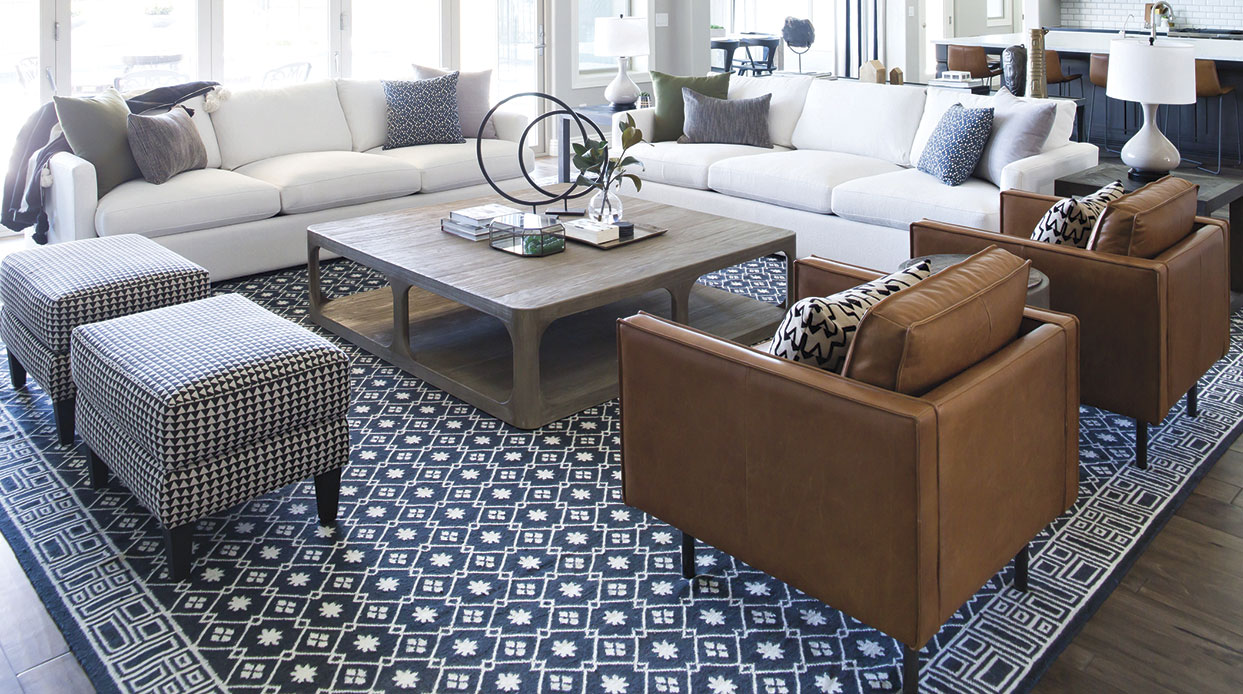New Voices

With innovative designs and fresh outlooks, today’s designers are creating homes that not only look fresh—they live fresh.
By Rebecca L. Rhoades| Photography by Brandon Sulllivan
Phoenix has a long past when it comes to architecture and home design. Neighborhood houses throughout the city spotlight various eras in time, from the compact Craftsman bungalows and Tudors of the early half of the 1900s that are scattered about the city’s historic districts, to the hidden clusters of midcentury modern gems by such lumi-
nary architects as Al Beadle, Blaine Drake, Ralph Haver and Bennie Gonzalez.
Today, a new crop of architects, builders and landscapers is making their own mark on the Valley of the Sun. With high levels of innovation, experimentation and design acumen, they’re moving forward by looking back to our city’s roots and developing homes and yards that respect our unique environment—and our Southwest lifestyle. From the use of sustainable materials to strategically placed windows designed to capture the sun’s rays throughout the day to expanded outdoor living spaces, even thoughtful modernizations of historic abodes, their homes challenge the norms, excite the senses and inspire dreams of the future.
On the following pages, we’ll introduce you to some of the top talent who are changing the way we look at—and live in—Arizona today.
IT’S A MOD, MOD WORLD
About five years ago, Dan Barnes was starting out in the house-flipping business when he met Michele Williams, who was disillusioned with her career. The two began dating and soon joined forces professionally, remodeling and selling homes under the label Mod Haus. Today, the life partners have moved on to building custom eye-catching abodes for clients.

Their look is clean, contemporary and approachable. “I like to call it an infusion of West Coast modern and midcentury modern,” says Williams. “We’re not cold contemporary, and we’re not completely midcentury. We like simple lines, monochromatic color palettes and the indoor/outdoor experience, as well as bringing natural woods and warmth into contemporary design.”
Gravitating toward downtown and Central Phoenix, the couple hopes to offer distinctive residences at affordable price points. “Phoenix has struggled with architecture in a lot of ways,” says Barnes. “We have so many of those developments filled with brown stucco homes and they all look alike.” A large percentage of Mod Haus’ clients are young professionals or families who are seeking homes that aren’t like any others on the block. “They want something that’s special to them.”
But being different doesn’t mean ignoring the concerns of the surrounding community. Barnes cites the example of a house they were building in the Dateland Homes neighborhood, which is filled with 1950s residences. The duo were planning on constructing a two-story structure on a small lot, but due to neighbor complaints about other contractors who had done similarly sized buildings, they rethought their design and decided to stick with a single story. “For us, it was more important to keep the continuity of the neighborhood,” he says. “We’re not about putting up a stucco box and destroying the character of the area. It’s about creating something new, better and unique, and hopefully that carries across to the public.”
Dan Barnes and Michele Williams have been designing and building custom homes in the greater Phoenix area for about five years. Their aesthetic is clean lines, monochromatic color palettes and a seamless connection between indoor and outdoor spaces. Inside, the look reflects midcentury design—simple, quiet and comfortable.
RESTORING HISTORY
Ron Elliott always knew that he wanted to get into architecture. “As a kid, I was constantly building or drawing things. Even now, if I need to explain something to someone, it’s easier for me to put an image together than it is to use words,” he says.
While studying at Arizona State University, Elliott got involved with Neighborhood Housing Services of Phoenix, a nonprofit organization that helped stabilize communities and rehab homes following the housing crisis of early 2000s. “That was my introduction to taking old homes and fixing them up,” he says. Upon graduation, he spent time working at local design/build firm Plus Minus Studio as well as Will Bruder Architects before branching out on his own.

Architectural designer Ron Elliott stands in front of an addition he added to a house on Evergreen Street. His preference is renovating and modernizing historic homes, inside and out—including the brick Craftsman-style home (below), which was given a clean, updated look.
Today, the architectural designer has created a niche for himself in renovating and modernizing historic homes. Sometimes it’s as simple as an interior remodel; other times, it’s affixing a new addition to an old home.
One of his favorite projects is also one of his firsts as a solo designer. The small brick bungalow on Evergreen Street desperately needed some extra square footage to make it functional for today’s buyers. Elliott devised a contemporary addition at the rear of the home—maintaining the look of the original house from the street while giving the interiors a much-desired upgrade. “It’s a clear separation of old and new,” he says. “It’s very obvious what was there originally and what has been added, but at the same time, it feels very cohesive.”
So what does Elliott hope to see happen with the future of Arizona home design? “A lot of things that I wanted to see are already happening,” he says. “Infill, vacant lots, older neighborhoods being fixed up and people taking pride in them. Downtown Phoenix is becoming a real urban city.”
FROM REAL ESTATE TO RENOVATION
“There are a lot of people who are doing unfortunate things to historic houses,” says Joel Contreras. The designer specializes upgrading homes in downtown Phoenix neighborhoods, where tiny historic bungalows are taking on new looks as homeowners seek the character of the older homes but desire the space and modern amenities of new builds.
As a real estate agent, he’s seen everything, from unpleasant additions that detract from the home’s authentic charm to the concealment—or removal—of such original features as brick walls or wood floors. “Our catchphrase in the Coronado District is ‘historically modern,’” Contreras says. “My rule is if it’s historic, keep it, or it sends the wrong message. We don’t tear down culture here.”

The designer’s first project was a modern glass-and-steel addition to a small brick house. The initial neighborhood response was “brutal,” he says. “I remember being torn to shreds for this design, but I did it anyway. After it was done, it became a crowd favorite.”
His personal residence is another example of his work. The small brick structure has been renovated with a contemporary, two-story black metal-clad addition in the back that greatly enlarges the interior square footage without sacrificing the historic aesthetic. The front facade retains its original appearance.
“It’s tough doing something different in historic districts, but according to housing guidelines, contemporary projects are supposed to be clearly distinguishable as new and of the present era with current construction methods,” Contreras notes. “You don’t want to create a false sense of history.
“I liken it to what I’ve seen in London or Amsterdam, or even New York City, where there’s this interruption of style or a 50/50 blend,” he continues. “It works when you have a glass-and-steel architectural tower next to something like the Chrysler Building and some brick rowhomes. It’s the juxtaposition of old and new, and it makes for a good recipe.”
Designer Joel Contreras used the knowledge he gained as a real estate agent to help him create beautiful and functional remodels of historic homes. Modern touches, such as steel cladding and floor-to-ceiling windows combine with exposed red brick and wood floors for unique and timeless designs.
EMBRACING OUTDOOR LIVING
No stranger to the Phoenix design industry, Trevor Tipton has been working in landscape and pool design/build for many years, although he just recently started his own business in Scottsdale.
“Our eight months of amazing weather allow us to spend time outside almost year-round,” he says. “People don’t get that everywhere else. So it’s important to have a landscape that is designed right and has multiple areas to use.”

As more and more homeowners recognize the benefits of outdoor living, they are wanting their exterior spaces to rival their interior rooms—from complete open-air kitchens and lounge areas to luxurious pools designed for swimming and relaxing.
“Builders and architects are bringing me on earlier in their projects because they want the homes to flow seamlessly to the outside,” Tipton notes. “Just in the last five years, backyard designs have changed so much, and clients have become so much smarter.”
According to the designer, native Arizonans who have lived in the Valley most or all of their lives are at the forefront of change. “They want a different style than the stacked stone, Southwest look that people coming from out of state desire,” he says. “They’re seeking a more contemporary look with really clean lines.”
Helping create these sleek landscapes are advances in technology, Tipton says, citing materials that stand up to our extreme climate, such as porcelain pavers that mimic wood and ceramic tiles; artificial turf that is thicker, cooler and more natural looking than its earlier counterparts; and app-based automated pool cleaning systems.
“We’re always going to be different from everywhere else in the U.S. for the most part,” Tipton notes. “You have Phoenix, Las Vegas and Palm Springs—this little circle of extreme heat. I’m interested to see what kind of modular, energy-efficient things will be coming out for the pool and landscape industry as technology advances.”
As interest in outdoor living increases, landscape and pool designer Trevor Tipton has been working to create yards that meet clients’ changing expectations. Whether it’s adding decorative tiles that reflect ones used inside on a pool fountain, situating an infinity-edge pool to take advantage of the view or adding a modern walkway to a front yard, Tipton strives for looks that are enduring.
CUSTOM CREATIONS
Construction runs in Evan Boxwell’s blood. Because his father was a custom home builder in Colorado, he learned the business from the ground up. After graduating from ASU with a degree in construction management—and following a brief stint with a build firm—he began buying, fixing and selling foreclosed properties. Today, he specializes in custom builds, ranging from contemporary designs to modern farmhouses.
“When I first started out here, everything looked the same—it was stucco Santa Barbara or Spanish-looking houses. And when you go to the suburbs, you see the same home over and over again,” he says. “There was a need for modern architecture. Something cool and fresh. Something that I would want to live in. So basically that’s what I started building.”

Boxwell’s personal home, in the Pierson Place Historic District, is a 1,530-square-foot contemporary, white-stucco design with wood and steel accents. Compatible in scale and material to neighboring homes, its clean lines, floor-to-ceiling windows and steel arbor-covered walkway stand out. Interest in the house was so great that he ended up developing three additional homes of similar style on the same street.
“I’m all for restoring existing historic homes to their original splendor, but if you’re building new in a historic neighborhood, you don’t want the house to look like all the others because its not of the same time period,” he says.
One of the biggest trends Boxwell sees for the future of home design is technology integration. “Voice command is going to be huge,” he predicts. “For example, using Alexa to control your whole house for automation and climate control.” As for the design of the home, “modern is where everything is going. The classic adobe works well out here, but the very contemporary glass, steel and concrete structure just fits in well with the landscape.”
Builder Evan Boxwell has his hands in numerous projects, from spec homes of his own design that utilize pattern and color (as seen in the kitchen above) to collaborations with architects, including the town home complex he worked on with The Ranch Mine.
For more information, see Sources.


















